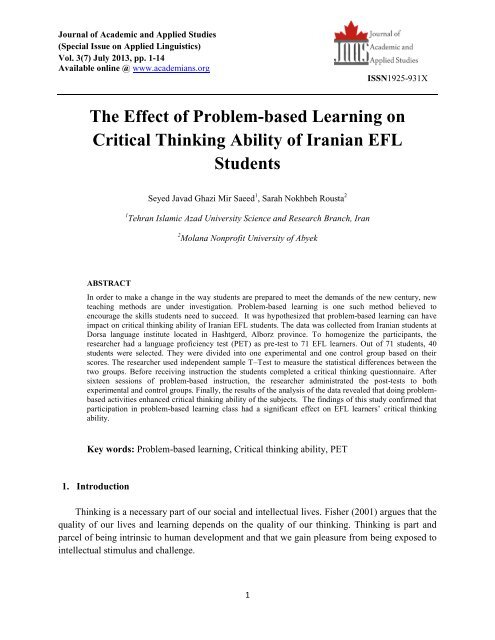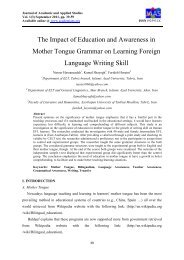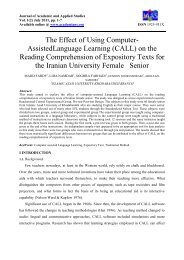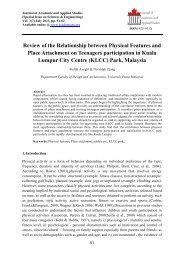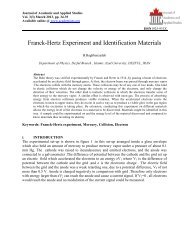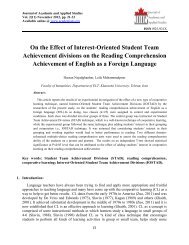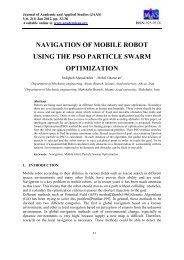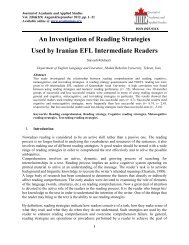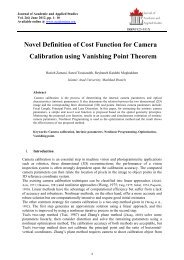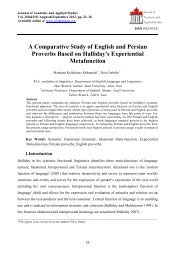The Effect of Problem-based Learning on Critical Thinking Ability of ...
The Effect of Problem-based Learning on Critical Thinking Ability of ...
The Effect of Problem-based Learning on Critical Thinking Ability of ...
Create successful ePaper yourself
Turn your PDF publications into a flip-book with our unique Google optimized e-Paper software.
Journal <str<strong>on</strong>g>of</str<strong>on</strong>g> Academic and Applied Studies<br />
(Special Issue <strong>on</strong> Applied Linguistics)<br />
Vol. 3(7) July 2013, pp. 1-14<br />
Available <strong>on</strong>line @ www.academians.org<br />
ISSN1925-931X<br />
<str<strong>on</strong>g>The</str<strong>on</strong>g> <str<strong>on</strong>g>Effect</str<strong>on</strong>g> <str<strong>on</strong>g>of</str<strong>on</strong>g> <str<strong>on</strong>g>Problem</str<strong>on</strong>g>-<str<strong>on</strong>g>based</str<strong>on</strong>g> <str<strong>on</strong>g>Learning</str<strong>on</strong>g> <strong>on</strong><br />
<strong>Critical</strong> <strong>Thinking</strong> <strong>Ability</strong> <str<strong>on</strong>g>of</str<strong>on</strong>g> Iranian EFL<br />
Students<br />
Seyed Javad Ghazi Mir Saeed 1 , Sarah Nokhbeh Rousta 2<br />
1 Tehran Islamic Azad University Science and Research Branch, Iran<br />
2 Molana N<strong>on</strong>pr<str<strong>on</strong>g>of</str<strong>on</strong>g>it University <str<strong>on</strong>g>of</str<strong>on</strong>g> Abyek<br />
ABSTRACT<br />
In order to make a change in the way students are prepared to meet the demands <str<strong>on</strong>g>of</str<strong>on</strong>g> the new century, new<br />
teaching methods are under investigati<strong>on</strong>. <str<strong>on</strong>g>Problem</str<strong>on</strong>g>-<str<strong>on</strong>g>based</str<strong>on</strong>g> learning is <strong>on</strong>e such method believed to<br />
encourage the skills students need to succeed. It was hypothesized that problem-<str<strong>on</strong>g>based</str<strong>on</strong>g> learning can have<br />
impact <strong>on</strong> critical thinking ability <str<strong>on</strong>g>of</str<strong>on</strong>g> Iranian EFL students. <str<strong>on</strong>g>The</str<strong>on</strong>g> data was collected from Iranian students at<br />
Dorsa language institute located in Hashtgerd, Alborz province. To homogenize the participants, the<br />
researcher had a language pr<str<strong>on</strong>g>of</str<strong>on</strong>g>iciency test (PET) as pre-test to 71 EFL learners. Out <str<strong>on</strong>g>of</str<strong>on</strong>g> 71 students, 40<br />
students were selected. <str<strong>on</strong>g>The</str<strong>on</strong>g>y were divided into <strong>on</strong>e experimental and <strong>on</strong>e c<strong>on</strong>trol group <str<strong>on</strong>g>based</str<strong>on</strong>g> <strong>on</strong> their<br />
scores. <str<strong>on</strong>g>The</str<strong>on</strong>g> researcher used independent sample T–Test to measure the statistical differences between the<br />
two groups. Before receiving instructi<strong>on</strong> the students completed a critical thinking questi<strong>on</strong>naire. After<br />
sixteen sessi<strong>on</strong>s <str<strong>on</strong>g>of</str<strong>on</strong>g> problem-<str<strong>on</strong>g>based</str<strong>on</strong>g> instructi<strong>on</strong>, the researcher administrated the post-tests to both<br />
experimental and c<strong>on</strong>trol groups. Finally, the results <str<strong>on</strong>g>of</str<strong>on</strong>g> the analysis <str<strong>on</strong>g>of</str<strong>on</strong>g> the data revealed that doing problem<str<strong>on</strong>g>based</str<strong>on</strong>g><br />
activities enhanced critical thinking ability <str<strong>on</strong>g>of</str<strong>on</strong>g> the subjects. <str<strong>on</strong>g>The</str<strong>on</strong>g> findings <str<strong>on</strong>g>of</str<strong>on</strong>g> this study c<strong>on</strong>firmed that<br />
participati<strong>on</strong> in problem-<str<strong>on</strong>g>based</str<strong>on</strong>g> learning class had a significant effect <strong>on</strong> EFL learners‟ critical thinking<br />
ability.<br />
Key words: <str<strong>on</strong>g>Problem</str<strong>on</strong>g>-<str<strong>on</strong>g>based</str<strong>on</strong>g> learning, <strong>Critical</strong> thinking ability, PET<br />
1. Introducti<strong>on</strong><br />
<strong>Thinking</strong> is a necessary part <str<strong>on</strong>g>of</str<strong>on</strong>g> our social and intellectual lives. Fisher (2001) argues that the<br />
quality <str<strong>on</strong>g>of</str<strong>on</strong>g> our lives and learning depends <strong>on</strong> the quality <str<strong>on</strong>g>of</str<strong>on</strong>g> our thinking. <strong>Thinking</strong> is part and<br />
parcel <str<strong>on</strong>g>of</str<strong>on</strong>g> being intrinsic to human development and that we gain pleasure from being exposed to<br />
intellectual stimulus and challenge.<br />
1
Journal <str<strong>on</strong>g>of</str<strong>on</strong>g> Academic and Applied Studies<br />
(Special Issue <strong>on</strong> Applied Linguistics)<br />
Vol. 3(7) July 2013, pp. 1-14<br />
Available <strong>on</strong>line @ www.academians.org<br />
ISSN1925-931X<br />
Acquiring thinking skills has been increasingly emphasized in educati<strong>on</strong>, especially with<br />
forces in globalizati<strong>on</strong> demanding its workers to be adaptable over and above being productive.<br />
Studies have recommended that students can no l<strong>on</strong>ger be “passive recipients <str<strong>on</strong>g>of</str<strong>on</strong>g> given<br />
informati<strong>on</strong>” and called for changes in pedagogical and learning envir<strong>on</strong>ments that are geared<br />
towards “developing thinking skills and harnessing creativity” (Yip, 1997, 391).Moreover, the<br />
changes in society also imply that the static acquisiti<strong>on</strong> <str<strong>on</strong>g>of</str<strong>on</strong>g> facts cannot adequately prepare<br />
students for the world bey<strong>on</strong>d the school envir<strong>on</strong>ment. Instead, schools should prepare students<br />
to be able to learn and think for themselves. And to do this, they need to be able to think<br />
“critically and creatively at the highest possible level” (Fisher, 2001, 8). It is a skill that would<br />
make for our students being innovative and effective in the modern workplace. But a simplistic<br />
way <str<strong>on</strong>g>of</str<strong>on</strong>g> looking at how <strong>on</strong>e thinks critically, we do not employ just <strong>on</strong>e specific thinking skill<br />
when we view our understanding <str<strong>on</strong>g>of</str<strong>on</strong>g> new informati<strong>on</strong> or <str<strong>on</strong>g>of</str<strong>on</strong>g> the world around us. Often we<br />
employ a broad array <str<strong>on</strong>g>of</str<strong>on</strong>g> these skills to interact meaningfully with knowledge. Fisher (2001, 21)<br />
proposes that critical thinking can be better defined as “skilled and active interpretati<strong>on</strong> and<br />
evaluati<strong>on</strong> <str<strong>on</strong>g>of</str<strong>on</strong>g> observati<strong>on</strong>s and communicati<strong>on</strong>s, informati<strong>on</strong> and argumentati<strong>on</strong> is sometimes<br />
syn<strong>on</strong>ymous with higher order thinking skills. It implies that the individual is inferring or<br />
c<strong>on</strong>cluding something <str<strong>on</strong>g>based</str<strong>on</strong>g> <strong>on</strong> some specific criteria.”<br />
Brookfield (1987, p.13) also argues that being a critical thinker “involves more than<br />
cognitive activities such as logical reas<strong>on</strong>ing or scrutinizing arguments for asserti<strong>on</strong>s<br />
unsupported by empirical evidence.” It also involves being able to recognize “<str<strong>on</strong>g>The</str<strong>on</strong>g> assumpti<strong>on</strong>s<br />
underlying our beliefs and behaviors give justificati<strong>on</strong>s for our ideas and acti<strong>on</strong>s and judge the<br />
rati<strong>on</strong>ality <str<strong>on</strong>g>of</str<strong>on</strong>g> these justificati<strong>on</strong>s.” We are then in a better positi<strong>on</strong> to “test the accuracy and<br />
rati<strong>on</strong>ality <str<strong>on</strong>g>of</str<strong>on</strong>g> these justificati<strong>on</strong>s against some kind <str<strong>on</strong>g>of</str<strong>on</strong>g> objective analysis <str<strong>on</strong>g>of</str<strong>on</strong>g> the „real‟ world as we<br />
understand it.” In other words, critical thinking requires a systematic m<strong>on</strong>itoring <str<strong>on</strong>g>of</str<strong>on</strong>g> thought. It is<br />
thinking that is assessed for its clarity, accuracy, relevance, depth, breadth, and logicalness.<br />
<strong>Critical</strong> thinking is <str<strong>on</strong>g>of</str<strong>on</strong>g>ten manifested in settings and domains that is divorced from the school<br />
or college classrooms. Hence it is not surprising that some researchers have shown that when a<br />
separate program is used as the „sole vehicle‟ for instructi<strong>on</strong> in thinking, the effectiveness <str<strong>on</strong>g>of</str<strong>on</strong>g> the<br />
transfer <str<strong>on</strong>g>of</str<strong>on</strong>g> such skills into other academic work and into everyday thinking is less automatic than<br />
what we would like it to be (Swartz, 1991, 177). Hence, if the ability to engage in c<strong>on</strong>tent in<br />
order to derive meaningful and logical c<strong>on</strong>clusi<strong>on</strong>s is our objective, we need to re-examine how<br />
we approach the teaching and applicati<strong>on</strong> <str<strong>on</strong>g>of</str<strong>on</strong>g> thinking skills in our school programs such that our<br />
students are able to decide what thinking skills are appropriate and how they should be<br />
dem<strong>on</strong>strated for deep learning to effectively take place.<br />
2
Journal <str<strong>on</strong>g>of</str<strong>on</strong>g> Academic and Applied Studies<br />
(Special Issue <strong>on</strong> Applied Linguistics)<br />
Vol. 3(7) July 2013, pp. 1-14<br />
Available <strong>on</strong>line @ www.academians.org<br />
ISSN1925-931X<br />
On the other hand PBL is a pedagogy where problems drive the thinking and learning<br />
process, rather than <strong>on</strong>e where a specific thinking skill is „taught‟ from the <strong>on</strong>set. It has its roots<br />
in c<strong>on</strong>structivist learning theories. It is an approach that challenges students to c<strong>on</strong>fr<strong>on</strong>t problems<br />
from real world c<strong>on</strong>texts that are vague and <str<strong>on</strong>g>of</str<strong>on</strong>g>ten ill-structured. It is a motivating, challenging,<br />
and enjoyable learning approach (Norman and Schmidt, 2000) that has resulted from the process<br />
<str<strong>on</strong>g>of</str<strong>on</strong>g> working towards understanding or resolving a problem. PBL was first introduced in the<br />
McMaster University in Canada in 1965. So<strong>on</strong> after that, in 1974, the McMaster medical school<br />
PBL model was established. This model inspired other universities to implement a similar design<br />
into their curriculum. Since then, PBL has been popularized and used in several higher<br />
educati<strong>on</strong>al instituti<strong>on</strong>s across the world. Some features <str<strong>on</strong>g>of</str<strong>on</strong>g> this pedagogy are:<br />
<br />
<br />
<br />
<br />
<br />
<str<strong>on</strong>g>Problem</str<strong>on</strong>g>-<str<strong>on</strong>g>based</str<strong>on</strong>g> learning is student-centered. PBL makes a fundamental shift from a focus<br />
<strong>on</strong> teaching to a focus <strong>on</strong> learning. <str<strong>on</strong>g>The</str<strong>on</strong>g> process is aimed at using the power <str<strong>on</strong>g>of</str<strong>on</strong>g> authentic<br />
problem solving to engage students and enhance their learning and motivati<strong>on</strong>. <str<strong>on</strong>g>The</str<strong>on</strong>g>re are<br />
several unique aspects that define the PBL approach:<br />
<str<strong>on</strong>g>Learning</str<strong>on</strong>g> takes place within the c<strong>on</strong>texts <str<strong>on</strong>g>of</str<strong>on</strong>g> authentic tasks, issues, and problems that are<br />
aligned with real-world c<strong>on</strong>cerns.<br />
In a PBL course, students and the instructor become co-learners, co-planners, coproducers,<br />
and co-evaluators as they design, implement, and c<strong>on</strong>tinually refine their<br />
curricula.<br />
<str<strong>on</strong>g>The</str<strong>on</strong>g> PBL approach is grounded in solid academic research <strong>on</strong> learning and <strong>on</strong> the best<br />
practices that promote it. This approach stimulates students to take resp<strong>on</strong>sibility for their<br />
own learning.<br />
PBL is unique in that it fosters collaborati<strong>on</strong> am<strong>on</strong>g students, stresses the development <str<strong>on</strong>g>of</str<strong>on</strong>g><br />
problem solving skills within the c<strong>on</strong>text <str<strong>on</strong>g>of</str<strong>on</strong>g> pr<str<strong>on</strong>g>of</str<strong>on</strong>g>essi<strong>on</strong>al practice, promotes effective<br />
reas<strong>on</strong>ing and self-directed learning, and is aimed at increasing motivati<strong>on</strong> for life-l<strong>on</strong>g<br />
learning.<br />
Generally teaching critical thinking is the same important as for an individual is being<br />
educated (Norris, 1985). Some authors point that teaching critical thinking is about teaching<br />
students to appropriately use c<strong>on</strong>cepts, principles, and procedures, so that they are capable <str<strong>on</strong>g>of</str<strong>on</strong>g><br />
3
Journal <str<strong>on</strong>g>of</str<strong>on</strong>g> Academic and Applied Studies<br />
(Special Issue <strong>on</strong> Applied Linguistics)<br />
Vol. 3(7) July 2013, pp. 1-14<br />
Available <strong>on</strong>line @ www.academians.org<br />
ISSN1925-931X<br />
producing fruitful outcomes and critical judgments . Additi<strong>on</strong>ally, critical thinking has an<br />
important implicati<strong>on</strong> for transfer <str<strong>on</strong>g>of</str<strong>on</strong>g> knowledge and applicati<strong>on</strong> <str<strong>on</strong>g>of</str<strong>on</strong>g> problem solving skills to<br />
novel situati<strong>on</strong>s (Garcia and Pintrich, 1992). In this capacity, several advantages for students<br />
learning are claimed for PBL to increase critical thinking ability.<br />
<strong>Critical</strong> thinking involves the formati<strong>on</strong> <str<strong>on</strong>g>of</str<strong>on</strong>g> logical inferences (Sim<strong>on</strong> & Kaplan, 1989).<br />
Some scholars and educators err<strong>on</strong>eously assume critical thinking to be higher order thinking or<br />
cognitive processing (Paul, 1994). According to Elder and Paul (1997), “<strong>Critical</strong> thinking is best<br />
understood as the ability <str<strong>on</strong>g>of</str<strong>on</strong>g> thinkers to take charge <str<strong>on</strong>g>of</str<strong>on</strong>g> their own thinking. This requires that they<br />
develop sound criteria and standards for analyzing and assessing their own thinking and<br />
routinely use those criteria and standards to improve its quality.”<br />
Typically, a PBL less<strong>on</strong> c<strong>on</strong>sists <str<strong>on</strong>g>of</str<strong>on</strong>g> a sessi<strong>on</strong> to introduce the problem, collaborative<br />
group discussi<strong>on</strong>s and a presentati<strong>on</strong> <str<strong>on</strong>g>of</str<strong>on</strong>g> findings. In PBL approaches, students do not merely<br />
learn through accumulating knowledge, but through c<strong>on</strong>structing an understanding <str<strong>on</strong>g>of</str<strong>on</strong>g> the<br />
c<strong>on</strong>cepts they encounter. Through a problem trigger, the learner explores ideas within a c<strong>on</strong>text,<br />
and in doing so, integrates the new c<strong>on</strong>cepts with his prior knowledge; through reflecti<strong>on</strong>, he<br />
c<strong>on</strong>structs a pers<strong>on</strong>al understanding <str<strong>on</strong>g>of</str<strong>on</strong>g> the knowledge. Lipman (2003, 21) argues that inquiry<br />
begins when there is a discrepancy in what we encounter. This captures our attenti<strong>on</strong> and<br />
demands our reflecti<strong>on</strong> and investigati<strong>on</strong>. In using problems to drive the acquisiti<strong>on</strong> <str<strong>on</strong>g>of</str<strong>on</strong>g> cognitive<br />
skills, problems are designed to be similar to real world situati<strong>on</strong>s. <str<strong>on</strong>g>The</str<strong>on</strong>g> students engage with the<br />
problem and the problem inquiry process creates cognitive diss<strong>on</strong>ance that stimulates learning.<br />
In working with real world scenarios, students get to apply the comp<strong>on</strong>ents <str<strong>on</strong>g>of</str<strong>on</strong>g> critical thought<br />
and acti<strong>on</strong>s that are interc<strong>on</strong>nected depending <strong>on</strong> many audiences and c<strong>on</strong>texts involved. Other<br />
than addressing the skills sets that are built into the problem scenarios, the beauty <str<strong>on</strong>g>of</str<strong>on</strong>g> working<br />
through <str<strong>on</strong>g>Problem</str<strong>on</strong>g>s are that the collaborative process <str<strong>on</strong>g>of</str<strong>on</strong>g> social negotiati<strong>on</strong> allows the student to<br />
evaluate the viability <str<strong>on</strong>g>of</str<strong>on</strong>g> his ideas.<br />
<str<strong>on</strong>g>The</str<strong>on</strong>g> c<strong>on</strong>cept <str<strong>on</strong>g>of</str<strong>on</strong>g> collaborative learning, the grouping and pairing <str<strong>on</strong>g>of</str<strong>on</strong>g> students for the<br />
purpose <str<strong>on</strong>g>of</str<strong>on</strong>g> achieving an academic goal has been widely researched and advocated throughout the<br />
pr<str<strong>on</strong>g>of</str<strong>on</strong>g>essi<strong>on</strong>al literature. <str<strong>on</strong>g>The</str<strong>on</strong>g> term “collaborative learning” refers to an instructi<strong>on</strong> method in<br />
which students at various performance levels work together in small groups toward a comm<strong>on</strong><br />
goal. <str<strong>on</strong>g>The</str<strong>on</strong>g> students are resp<strong>on</strong>sible for <strong>on</strong>e another‟s learning as well as their own. Thus, the<br />
success <str<strong>on</strong>g>of</str<strong>on</strong>g> <strong>on</strong>e student helps other students to be successful. Prop<strong>on</strong>ents <str<strong>on</strong>g>of</str<strong>on</strong>g> collaborative learning<br />
claim that the active exchange <str<strong>on</strong>g>of</str<strong>on</strong>g> ideas within small groups not <strong>on</strong>ly increases interest am<strong>on</strong>g the<br />
participants but also promotes critical thinking. According to Johns<strong>on</strong> and Johns<strong>on</strong> (1986), there<br />
4
Journal <str<strong>on</strong>g>of</str<strong>on</strong>g> Academic and Applied Studies<br />
(Special Issue <strong>on</strong> Applied Linguistics)<br />
Vol. 3(7) July 2013, pp. 1-14<br />
Available <strong>on</strong>line @ www.academians.org<br />
ISSN1925-931X<br />
is persuasive evidence that cooperative teams achieve at higher levels <str<strong>on</strong>g>of</str<strong>on</strong>g> thought and retain<br />
informati<strong>on</strong> l<strong>on</strong>ger than students who work quietly as individuals. <str<strong>on</strong>g>The</str<strong>on</strong>g> shared learning gives<br />
students an opportunity to engage in discussi<strong>on</strong>, take resp<strong>on</strong>sibility for their own learning, and<br />
thus become critical thinkers (Totten, Sills, Digby, & Russ, 1991).<br />
To effectively implement PBL, teachers must adopt new roles that are frequently very<br />
different from those <str<strong>on</strong>g>of</str<strong>on</strong>g> their past. In lecture-<str<strong>on</strong>g>based</str<strong>on</strong>g> instructi<strong>on</strong>, the teacher is in c<strong>on</strong>trol and is the<br />
"expert" dispensing knowledge. In PBL, the teacher selects the problem, presents it to the<br />
students, and then provides directi<strong>on</strong> for student research and inquiry. <str<strong>on</strong>g>The</str<strong>on</strong>g> teacher functi<strong>on</strong>s as a<br />
facilitator, and the student c<strong>on</strong>trols the problem-solving process. For many teachers, such a<br />
change is untenable. One teacher assisting in research reported by Boud and Feletti (1991) wrote<br />
<strong>on</strong> the exit evaluati<strong>on</strong>, "I can't handle this. I want to be in total c<strong>on</strong>trol and PBL doesn't allow<br />
that" (p. 132). <str<strong>on</strong>g>The</str<strong>on</strong>g>se teachers flounder without the c<strong>on</strong>trol and "power" typical in lecture-<str<strong>on</strong>g>based</str<strong>on</strong>g><br />
classes. Another factor inhibiting change was noted by Albi<strong>on</strong> and Gibs<strong>on</strong> (2000) and Novak<br />
(1990) in teacher educati<strong>on</strong> programs. Most <str<strong>on</strong>g>of</str<strong>on</strong>g> these programs still rely heavily <strong>on</strong> rote learning<br />
and traditi<strong>on</strong>al lecture formats. It is difficult to expect teachers to adopt learning methodologies<br />
that they have not experienced pers<strong>on</strong>ally or through their teacher educati<strong>on</strong> programs. With<br />
many administrators, curriculum developers, and teachers lacking experience in interdisciplinary<br />
educati<strong>on</strong>, barriers to broad scale change can become insurmountable. Another barrier to PBL is<br />
the lack <str<strong>on</strong>g>of</str<strong>on</strong>g> prepared materials for classroom instructi<strong>on</strong>. Few training materials are available.<br />
Present curriculum guides and textbooks do not c<strong>on</strong>tain the variety <str<strong>on</strong>g>of</str<strong>on</strong>g> sample problems or<br />
assessment tools needed to support this methodology <strong>on</strong> a broad scale. <str<strong>on</strong>g>The</str<strong>on</strong>g> philosophies<br />
supporting PBL are well established, but the "how toss" are in short supply (Burruss, 1999). Few<br />
teachers have the time or the motivati<strong>on</strong> to prepare all new materials for classes. Not <strong>on</strong>ly are illstructured<br />
problems unavailable for much <str<strong>on</strong>g>of</str<strong>on</strong>g> the public school curricula, but most accountability<br />
assessment that is presently in use is product driven and knowledge <str<strong>on</strong>g>based</str<strong>on</strong>g>. Teachers' and<br />
students' performances are examined in light <str<strong>on</strong>g>of</str<strong>on</strong>g> standardized testing that does not address critical<br />
thinking process skills. Meier et al. (1996) report that with many time c<strong>on</strong>straints and<br />
administrative pressures to improve test scores, many teachers will not believe they can justify<br />
the time necessary for PBL.<br />
Base <strong>on</strong> the above menti<strong>on</strong>ed ideas, the purpose <str<strong>on</strong>g>of</str<strong>on</strong>g> this study is to investigate the effect <str<strong>on</strong>g>of</str<strong>on</strong>g> PBL<br />
<strong>on</strong> critical thinking ability <str<strong>on</strong>g>of</str<strong>on</strong>g> Iranian EFL students. So in line with the purpose <str<strong>on</strong>g>of</str<strong>on</strong>g> the study, the<br />
researcher is going to find answer to the following questi<strong>on</strong>, and In keeping with the research<br />
questi<strong>on</strong>, the following hypothesis is also stated.<br />
RQ: Does problem-<str<strong>on</strong>g>based</str<strong>on</strong>g> learning have any significant effect <strong>on</strong> Iranian EFL learners‟ level<br />
<str<strong>on</strong>g>of</str<strong>on</strong>g> critical thinking ability<br />
5
Journal <str<strong>on</strong>g>of</str<strong>on</strong>g> Academic and Applied Studies<br />
(Special Issue <strong>on</strong> Applied Linguistics)<br />
Vol. 3(7) July 2013, pp. 1-14<br />
Available <strong>on</strong>line @ www.academians.org<br />
ISSN1925-931X<br />
Ho: Participati<strong>on</strong> in problem-<str<strong>on</strong>g>based</str<strong>on</strong>g> learning classes has no effect <strong>on</strong> EFL learners‟ level <str<strong>on</strong>g>of</str<strong>on</strong>g><br />
critical thinking skills.<br />
2. Methodology<br />
This study used a quasi-experimental research design with two groups. <str<strong>on</strong>g>The</str<strong>on</strong>g> participants<br />
were 40 male and female intermediate EFL learners from the same academic backgrounds,<br />
ranging in age from 15 to 23, learning English at Dorsa language institute at Hashtgerd, Alborz<br />
province. To ensure the homogeneity <str<strong>on</strong>g>of</str<strong>on</strong>g> the subjects in terms <str<strong>on</strong>g>of</str<strong>on</strong>g> their language pr<str<strong>on</strong>g>of</str<strong>on</strong>g>iciency<br />
several criteria were taken into c<strong>on</strong>siderati<strong>on</strong>. <str<strong>on</strong>g>The</str<strong>on</strong>g> researcher chose students who were studying<br />
English at the same level. In fact these students had passed placement test <str<strong>on</strong>g>of</str<strong>on</strong>g> language school<br />
before entering intermediate level. <str<strong>on</strong>g>The</str<strong>on</strong>g>ir scores in these exams had met language schools criteria.<br />
This showed that they were successful at passing the previous terms by obtaining acceptable<br />
scores. Moreover, to ensure the homogeneity <str<strong>on</strong>g>of</str<strong>on</strong>g> the participants apart from language school<br />
criteri<strong>on</strong>, the researcher administered PET, a language pr<str<strong>on</strong>g>of</str<strong>on</strong>g>iciency test, to 71 EFL students as a<br />
pretest. Before the main administrati<strong>on</strong>, the PET was piloted in c<strong>on</strong>diti<strong>on</strong>s similar to the main<br />
study to ensure its reliability for the target sample. <str<strong>on</strong>g>The</str<strong>on</strong>g> pilot group c<strong>on</strong>sisted <str<strong>on</strong>g>of</str<strong>on</strong>g> 30 participants <str<strong>on</strong>g>of</str<strong>on</strong>g><br />
similar characteristics to the target group. <str<strong>on</strong>g>The</str<strong>on</strong>g>n, the final versi<strong>on</strong> <str<strong>on</strong>g>of</str<strong>on</strong>g> the piloted PET was<br />
administered to the target sample. From am<strong>on</strong>g the learners who took part in the testing sessi<strong>on</strong>,<br />
learners whose scores were 0.8 standard deviati<strong>on</strong> above and below the mean were selected as<br />
the subjects <str<strong>on</strong>g>of</str<strong>on</strong>g> the study. Out <str<strong>on</strong>g>of</str<strong>on</strong>g> 71 students, 40 students were selected. <str<strong>on</strong>g>The</str<strong>on</strong>g>y were randomly<br />
divided into <strong>on</strong>e experimental and <strong>on</strong>e c<strong>on</strong>trol group <str<strong>on</strong>g>based</str<strong>on</strong>g> <strong>on</strong> their scores (each group c<strong>on</strong>sisted<br />
<str<strong>on</strong>g>of</str<strong>on</strong>g> 20 students). Each group included both male and female students. <str<strong>on</strong>g>The</str<strong>on</strong>g>n the researcher used<br />
independent sample T–test to measure the statistical difference between two groups. This<br />
revealed that there is no significant difference between two groups.<br />
In the current research, the pretest–posttest c<strong>on</strong>trol group design was implemented to<br />
investigate the effects <str<strong>on</strong>g>of</str<strong>on</strong>g> the independent variable <strong>on</strong> dependent variable (i.e. critical thinking<br />
skill <str<strong>on</strong>g>of</str<strong>on</strong>g> EFL learners).This design examined the effect <str<strong>on</strong>g>of</str<strong>on</strong>g> an interventi<strong>on</strong> between two groups, the<br />
experimental and c<strong>on</strong>trol groups, and was acceptable to evaluate the effect <str<strong>on</strong>g>of</str<strong>on</strong>g> a treatment since<br />
randomizati<strong>on</strong> is not feasible. <str<strong>on</strong>g>The</str<strong>on</strong>g>re were two groups <str<strong>on</strong>g>of</str<strong>on</strong>g> participants: <str<strong>on</strong>g>The</str<strong>on</strong>g> experimental group<br />
who participated in problem-<str<strong>on</strong>g>based</str<strong>on</strong>g> class, and the learners in c<strong>on</strong>trol group who practiced the<br />
same activities without problem-<str<strong>on</strong>g>based</str<strong>on</strong>g> assignments. Both groups were given pre-test at the<br />
beginning and post-test at the end in order to see the possible effects <str<strong>on</strong>g>of</str<strong>on</strong>g> the treatment <strong>on</strong> EFL<br />
learners in experimental group. <str<strong>on</strong>g>The</str<strong>on</strong>g> experiment took place in eight weeks. <str<strong>on</strong>g>The</str<strong>on</strong>g> c<strong>on</strong>trol group did<br />
the same activities in classroom. During the experiment, the teacher m<strong>on</strong>itored both groups in<br />
order to figure out and follow their progress. In order to find the influence <str<strong>on</strong>g>of</str<strong>on</strong>g> experiment,<br />
independent sample t-test was used. In this study gender was not c<strong>on</strong>sidered as a moderator<br />
6
Journal <str<strong>on</strong>g>of</str<strong>on</strong>g> Academic and Applied Studies<br />
(Special Issue <strong>on</strong> Applied Linguistics)<br />
Vol. 3(7) July 2013, pp. 1-14<br />
Available <strong>on</strong>line @ www.academians.org<br />
ISSN1925-931X<br />
variable, so its potential effects <strong>on</strong> the results had not been separately taken into c<strong>on</strong>siderati<strong>on</strong>.<br />
On the other hand, English language pr<str<strong>on</strong>g>of</str<strong>on</strong>g>iciency <str<strong>on</strong>g>of</str<strong>on</strong>g> the participants was c<strong>on</strong>sidered as the c<strong>on</strong>trol<br />
variable as the participants were homogenized <str<strong>on</strong>g>based</str<strong>on</strong>g> <strong>on</strong> their language pr<str<strong>on</strong>g>of</str<strong>on</strong>g>iciency.<br />
In order to carry out this study, a sample <str<strong>on</strong>g>of</str<strong>on</strong>g> Preliminary English Test (PET) adopted from<br />
PET Practice Tests by Jenny Quintana (2003), Oxford University Press was used as a pretest to<br />
homogenize participants in terms <str<strong>on</strong>g>of</str<strong>on</strong>g> their general English language pr<str<strong>on</strong>g>of</str<strong>on</strong>g>iciency. Before<br />
administering the test, it was piloted with a group <str<strong>on</strong>g>of</str<strong>on</strong>g> 30 EFL learners who were at the same<br />
language pr<str<strong>on</strong>g>of</str<strong>on</strong>g>iciency level as the participants <str<strong>on</strong>g>of</str<strong>on</strong>g> the study. Item analysis and reliability estimates<br />
were carried out after the pilot administrati<strong>on</strong>. Analysis <str<strong>on</strong>g>of</str<strong>on</strong>g> the results included in tables 1, 2, 3<br />
and 4 indicating that no items were required to be discarded.<br />
Total score<br />
Valid N 30<br />
Total PET<br />
(Reading, Listening, Writing)<br />
Table.1. Descriptive Statistics <str<strong>on</strong>g>of</str<strong>on</strong>g> the PET pilot study<br />
N Minimum Maximum Mean Std. Deviati<strong>on</strong><br />
Statistic Statistic Statistic Statistic Std. Error Statistic<br />
30 16 62 37.84 2.75 15.09<br />
Table.2. Reliability Estimate <str<strong>on</strong>g>of</str<strong>on</strong>g> the PET Pilot Study<br />
Number <str<strong>on</strong>g>of</str<strong>on</strong>g> participants Number <str<strong>on</strong>g>of</str<strong>on</strong>g> items Cr<strong>on</strong>bach’s Alpha<br />
30 65 .946<br />
Table .3. Descriptive Statistics <str<strong>on</strong>g>of</str<strong>on</strong>g> the PET Main Administrati<strong>on</strong><br />
Total score<br />
N<br />
Minimum<br />
Maximum<br />
Statistic Statistic Statistic Statisti<br />
c<br />
Mean<br />
Std.<br />
Error<br />
Std. Deviati<strong>on</strong><br />
Statistic<br />
71 18 62 40.24 1.87 11.45<br />
Valid N 71<br />
Table .4. Reliability Estimate <str<strong>on</strong>g>of</str<strong>on</strong>g> the PET Main Administrati<strong>on</strong><br />
Number <str<strong>on</strong>g>of</str<strong>on</strong>g> participants Number <str<strong>on</strong>g>of</str<strong>on</strong>g> items Cr<strong>on</strong>bach’s Alpha<br />
71 65 0.923<br />
7
Journal <str<strong>on</strong>g>of</str<strong>on</strong>g> Academic and Applied Studies<br />
(Special Issue <strong>on</strong> Applied Linguistics)<br />
Vol. 3(7) July 2013, pp. 1-14<br />
Available <strong>on</strong>line @ www.academians.org<br />
ISSN1925-931X<br />
Peter H<strong>on</strong>ey's critical thinking questi<strong>on</strong>naire was used in this study to measure the<br />
participants‟ critical thinking skills and was administered as both pretest and posttest with the<br />
aim <str<strong>on</strong>g>of</str<strong>on</strong>g> identifying any possible impact <str<strong>on</strong>g>of</str<strong>on</strong>g> the treatment <strong>on</strong> the development <str<strong>on</strong>g>of</str<strong>on</strong>g> the critical<br />
thinking skill <str<strong>on</strong>g>of</str<strong>on</strong>g> the participants. This questi<strong>on</strong>naire is c<strong>on</strong>structed by H<strong>on</strong>ey (2005) with the<br />
purpose <str<strong>on</strong>g>of</str<strong>on</strong>g> evaluating the skills <str<strong>on</strong>g>of</str<strong>on</strong>g> analysis, inference, evaluati<strong>on</strong>, and reas<strong>on</strong>ing. <str<strong>on</strong>g>The</str<strong>on</strong>g><br />
questi<strong>on</strong>naire included 30 Likert type questi<strong>on</strong>s each followed by five alternatives including<br />
Never(1), Rarely(2), Sometimes(3), Often(4), and Always(5). Each participant‟s score could<br />
range from 30 to 150.<br />
<str<strong>on</strong>g>The</str<strong>on</strong>g> method <str<strong>on</strong>g>of</str<strong>on</strong>g> sampling in this research was n<strong>on</strong>random c<strong>on</strong>venience sampling.<br />
Researchers used the subjects that were available to participate in this research study. <str<strong>on</strong>g>The</str<strong>on</strong>g><br />
participants were 40 male and female intermediate EFL learners from the same academic<br />
backgrounds, ranging in age from 15 to 23, learning English at Dorsa language institute at<br />
Hashtgerd, Alborz province. To ensure the homogeneity <str<strong>on</strong>g>of</str<strong>on</strong>g> the subjects in terms <str<strong>on</strong>g>of</str<strong>on</strong>g> their<br />
language pr<str<strong>on</strong>g>of</str<strong>on</strong>g>iciency several criteria were taken into c<strong>on</strong>siderati<strong>on</strong>. <str<strong>on</strong>g>The</str<strong>on</strong>g> researcher chose<br />
students who were studying English at the same level. In fact these students had passed<br />
placement test <str<strong>on</strong>g>of</str<strong>on</strong>g> language school before entering intermediate level. <str<strong>on</strong>g>The</str<strong>on</strong>g>ir scores in these exams<br />
had met language schools criteria. This showed that they were successful at passing the previous<br />
terms by obtaining acceptable scores. Moreover, to ensure the homogeneity <str<strong>on</strong>g>of</str<strong>on</strong>g> the participants<br />
apart from language school criteri<strong>on</strong>, the researcher administered PET, a language pr<str<strong>on</strong>g>of</str<strong>on</strong>g>iciency<br />
test, to 71 EFL students as a pretest. Before the main administrati<strong>on</strong>, the PET was piloted in<br />
c<strong>on</strong>diti<strong>on</strong>s similar to the main study to ensure its reliability for the target sample. <str<strong>on</strong>g>The</str<strong>on</strong>g> pilot group<br />
c<strong>on</strong>sisted <str<strong>on</strong>g>of</str<strong>on</strong>g> 30 participants <str<strong>on</strong>g>of</str<strong>on</strong>g> similar characteristics to the target group. <str<strong>on</strong>g>The</str<strong>on</strong>g>n, the final versi<strong>on</strong><br />
<str<strong>on</strong>g>of</str<strong>on</strong>g> the piloted PET was administered to the target sample. From am<strong>on</strong>g the learners who took<br />
part in the testing sessi<strong>on</strong>, learners whose scores were 0.8 standard deviati<strong>on</strong> above and below<br />
the mean were selected as the subjects <str<strong>on</strong>g>of</str<strong>on</strong>g> the study. Out <str<strong>on</strong>g>of</str<strong>on</strong>g> 71 students, 40 students were<br />
selected. <str<strong>on</strong>g>The</str<strong>on</strong>g>y were randomly divided into <strong>on</strong>e experimental and <strong>on</strong>e c<strong>on</strong>trol group <str<strong>on</strong>g>based</str<strong>on</strong>g> <strong>on</strong><br />
their scores (each group c<strong>on</strong>sisted <str<strong>on</strong>g>of</str<strong>on</strong>g> 20 students). Each group included both male and female<br />
students. <str<strong>on</strong>g>The</str<strong>on</strong>g>n the researcher used independent sample T–test to measure the statistical<br />
difference between two groups. This revealed that there is no significant difference between two<br />
groups table 5.<br />
Prior to the experiment, the researcher used the Peter H<strong>on</strong>ey's critical thinking<br />
questi<strong>on</strong>naire to measure the participants‟ critical thinking skills. It was used to evaluate the<br />
skills <str<strong>on</strong>g>of</str<strong>on</strong>g> analysis, inference, evaluati<strong>on</strong>, and reas<strong>on</strong>ing <str<strong>on</strong>g>of</str<strong>on</strong>g> students. Since the participants in both<br />
groups were at intermediate level <str<strong>on</strong>g>of</str<strong>on</strong>g> language pr<str<strong>on</strong>g>of</str<strong>on</strong>g>iciency, the English versi<strong>on</strong>s <str<strong>on</strong>g>of</str<strong>on</strong>g> the two<br />
questi<strong>on</strong>naires were used in this study. <str<strong>on</strong>g>The</str<strong>on</strong>g> textbook used in this study in both groups was<br />
8
sig.<br />
(2-tailed)<br />
Mean<br />
Difference<br />
Std. Error<br />
Difference<br />
Journal <str<strong>on</strong>g>of</str<strong>on</strong>g> Academic and Applied Studies<br />
(Special Issue <strong>on</strong> Applied Linguistics)<br />
Vol. 3(7) July 2013, pp. 1-14<br />
Available <strong>on</strong>line @ www.academians.org<br />
ISSN1925-931X<br />
interchange 3 (Jack C. Richards, 2005 third editi<strong>on</strong>), depending <strong>on</strong> the exact level <str<strong>on</strong>g>of</str<strong>on</strong>g> the<br />
participants. During the experiment, the participants in both groups received the same amount <str<strong>on</strong>g>of</str<strong>on</strong>g><br />
instructi<strong>on</strong> and also the same method <str<strong>on</strong>g>of</str<strong>on</strong>g> teaching was used in both groups. In the beginning the<br />
teacher familiarized the learners in treatment group with the course and requirements. He made<br />
sure students understand the goals and benefits <str<strong>on</strong>g>of</str<strong>on</strong>g> a <str<strong>on</strong>g>Problem</str<strong>on</strong>g>-<str<strong>on</strong>g>based</str<strong>on</strong>g> approach for language<br />
learning and explained what they are going to do during the course. He emphasized the<br />
importance <str<strong>on</strong>g>of</str<strong>on</strong>g> using English in problem-solving activities.<br />
Table.5.<str<strong>on</strong>g>The</str<strong>on</strong>g> Results <str<strong>on</strong>g>of</str<strong>on</strong>g> Independent Sample T-test Between C<strong>on</strong>trol and Experimental group<br />
Equal variances<br />
assumed<br />
Equal variances<br />
not assumed<br />
Levene's Test for<br />
Equality <str<strong>on</strong>g>of</str<strong>on</strong>g><br />
Variances<br />
F sig. t df<br />
t-test for Equality <str<strong>on</strong>g>of</str<strong>on</strong>g> Means<br />
95% C<strong>on</strong>fidence<br />
Interval <str<strong>on</strong>g>of</str<strong>on</strong>g> the<br />
Difference<br />
Lower<br />
Upper<br />
8.686 .005 -10.243 38 .000 -24.65000 2.40643 -29.52157 -19.77843<br />
-10.243 29.054 .000 -24.65000 2.40643 -29.57131 -19.72869<br />
In the following sessi<strong>on</strong>s the researcher introduced problems to the students by using<br />
examples; the teacher provided them with related vocabularies and asks students about previous<br />
pers<strong>on</strong>al experiences with the problem. He made sure that students understand the problem and<br />
the expectati<strong>on</strong>s. <str<strong>on</strong>g>The</str<strong>on</strong>g> group brainstormed possible soluti<strong>on</strong>s/hypotheses <str<strong>on</strong>g>based</str<strong>on</strong>g> <strong>on</strong> the available<br />
knowledge and informati<strong>on</strong>. <str<strong>on</strong>g>The</str<strong>on</strong>g> students discussed the problem in small groups (each group 5<br />
students). <str<strong>on</strong>g>The</str<strong>on</strong>g>n the group decided what further informati<strong>on</strong> is needed to solve the problem, prove<br />
or disprove hypotheses. He emphasized that there is no single answer or soluti<strong>on</strong>, and that they<br />
need to choose what appears to be the most viable soluti<strong>on</strong> to them and be prepared to explain<br />
why they chose that soluti<strong>on</strong>. <str<strong>on</strong>g>The</str<strong>on</strong>g> teacher observed students and provided support as needed, but<br />
didn‟t attempt to direct their efforts or c<strong>on</strong>trol their activity in solving the problem. He observed<br />
and provided feedback <strong>on</strong> student participati<strong>on</strong> in the activity and <strong>on</strong> language used during the<br />
activity then provided students with opportunities to present and share the results <str<strong>on</strong>g>of</str<strong>on</strong>g> their work.<br />
<str<strong>on</strong>g>The</str<strong>on</strong>g>y reviewed what they have learned from working <strong>on</strong> the problem. <str<strong>on</strong>g>The</str<strong>on</strong>g> teacher gave followup<br />
activities <str<strong>on</strong>g>based</str<strong>on</strong>g> <strong>on</strong> his observati<strong>on</strong>s; e.g., instructi<strong>on</strong>s <strong>on</strong> grammar, vocabulary and<br />
pr<strong>on</strong>unciati<strong>on</strong>. He assessed students‟ participati<strong>on</strong> and success in the activity.<br />
9
Journal <str<strong>on</strong>g>of</str<strong>on</strong>g> Academic and Applied Studies<br />
(Special Issue <strong>on</strong> Applied Linguistics)<br />
Vol. 3(7) July 2013, pp. 1-14<br />
Available <strong>on</strong>line @ www.academians.org<br />
ISSN1925-931X<br />
Depending <strong>on</strong> the complexity <str<strong>on</strong>g>of</str<strong>on</strong>g> the problem, more research was needed as the group<br />
narrowed the possible soluti<strong>on</strong>s. For example <strong>on</strong>e problem which was introduced in the class was<br />
a letter from some<strong>on</strong>e who announces his/her arrival and students must prepare everything in<br />
order to receive the guest. <str<strong>on</strong>g>The</str<strong>on</strong>g> students will try to find how to entertain the guest, which tourist<br />
objectives will visit, which hotel is the best and which food will they prepare for the guest. For<br />
both experimental and c<strong>on</strong>trol groups, it was not necessary to have a c<strong>on</strong>clusi<strong>on</strong> at the end <str<strong>on</strong>g>of</str<strong>on</strong>g> the<br />
process. However, some discussi<strong>on</strong>s resulted in c<strong>on</strong>clusi<strong>on</strong>s and the participants could move to<br />
the next topic. In fact at the last 30 minutes <str<strong>on</strong>g>of</str<strong>on</strong>g> each sessi<strong>on</strong> <str<strong>on</strong>g>of</str<strong>on</strong>g> classes the participants in the<br />
treatment group were asked to discuss the problems with their classmates in the class. It was<br />
estimated that each participant in the experimental group would work <strong>on</strong> problems at home<br />
before coming to the class. All the activities in both groups were c<strong>on</strong>sidered as their assignments.<br />
Sixteen sessi<strong>on</strong>s were held twice a week for both groups.<br />
<str<strong>on</strong>g>The</str<strong>on</strong>g> SPSS 15.0 package program was used for the analysis <str<strong>on</strong>g>of</str<strong>on</strong>g> data. “Independent sample t-<br />
test” was used in order to determine whether problem-<str<strong>on</strong>g>based</str<strong>on</strong>g> learning has any effect <strong>on</strong> critical<br />
thinking <str<strong>on</strong>g>of</str<strong>on</strong>g> Iranian intermediate EFL students. Before applying statistical methods, it was<br />
necessary to make sure that the assumpti<strong>on</strong> <str<strong>on</strong>g>of</str<strong>on</strong>g> the normality <str<strong>on</strong>g>of</str<strong>on</strong>g> the collected data was not<br />
violated. One comm<strong>on</strong> test for checking the normality is Shapiro-Wilk test. <str<strong>on</strong>g>The</str<strong>on</strong>g> null hypothesis<br />
<str<strong>on</strong>g>of</str<strong>on</strong>g> Shapiro-Wilk test is that the samples are taken from a normal distributi<strong>on</strong>. So, because the p<br />
value <str<strong>on</strong>g>of</str<strong>on</strong>g> the data, in this study, <strong>on</strong> the Peter H<strong>on</strong>ey's <strong>Critical</strong> <strong>Thinking</strong> Questi<strong>on</strong>naire was greater<br />
than .05, the researchers c<strong>on</strong>firmed the null hypothesis, and understood that the samples are<br />
taken from a normal distributi<strong>on</strong>. Thus, the researchers needed to use parametric tests. It is worth<br />
to menti<strong>on</strong> that after eleven sessi<strong>on</strong>s <str<strong>on</strong>g>of</str<strong>on</strong>g> problem-<str<strong>on</strong>g>based</str<strong>on</strong>g> learning classes, and obtaining needed<br />
informati<strong>on</strong> regarding the acceptance or rejecti<strong>on</strong> <str<strong>on</strong>g>of</str<strong>on</strong>g> the null hypothesis, the gain scores from<br />
pretests to posttests were computed for each participant by subtracting each pers<strong>on</strong>'s pretest<br />
scores from his or her posttest scores.<br />
<str<strong>on</strong>g>The</str<strong>on</strong>g> level <str<strong>on</strong>g>of</str<strong>on</strong>g> significance was set at .05. <str<strong>on</strong>g>The</str<strong>on</strong>g>n the researchers referred to p-value which was<br />
computed by SPSS. <str<strong>on</strong>g>The</str<strong>on</strong>g> level <str<strong>on</strong>g>of</str<strong>on</strong>g> significance was set at .05 result was .00. <str<strong>on</strong>g>The</str<strong>on</strong>g> p-value<br />
associated with the t-test is smaller than t-critical (< .05), so there is evidence to reject the null<br />
hypothesis. In other words, there is evidence that the mean is significantly different at the<br />
significance level reported by the p-value. Since the p-value is lower than its t-critical value, it<br />
can be claimed that problem-<str<strong>on</strong>g>based</str<strong>on</strong>g> learning has a significant impact <strong>on</strong> the critical thinking <str<strong>on</strong>g>of</str<strong>on</strong>g><br />
Iranian intermediate EFL students. Thus the null-hypothesis is rejected.<br />
Results <str<strong>on</strong>g>of</str<strong>on</strong>g> reliability statistics <str<strong>on</strong>g>of</str<strong>on</strong>g> <strong>Critical</strong> <strong>Thinking</strong> Questi<strong>on</strong>naire <str<strong>on</strong>g>of</str<strong>on</strong>g> pre-test and post-test<br />
were .90 and .92 respectively (Table.6). C<strong>on</strong>sidering the data and in answer to research questi<strong>on</strong>,<br />
10
Journal <str<strong>on</strong>g>of</str<strong>on</strong>g> Academic and Applied Studies<br />
(Special Issue <strong>on</strong> Applied Linguistics)<br />
Vol. 3(7) July 2013, pp. 1-14<br />
Available <strong>on</strong>line @ www.academians.org<br />
ISSN1925-931X<br />
a significantly positive effect was found between the problem-<str<strong>on</strong>g>based</str<strong>on</strong>g> learning and critical<br />
thinking. When comparing the gain scores between the c<strong>on</strong>trol group and the experimental<br />
group, the researchers found a very significant difference between the treatment and c<strong>on</strong>trol<br />
group‟s critical thinking. This shows that problem-<str<strong>on</strong>g>based</str<strong>on</strong>g> learning helps students improve critical<br />
thinking. Other tables <str<strong>on</strong>g>of</str<strong>on</strong>g> informati<strong>on</strong> are presented in the appendix.<br />
Table.6. Reliability Statistics <str<strong>on</strong>g>of</str<strong>on</strong>g> CT Questi<strong>on</strong>naire Pretest and Posttest<br />
Number <str<strong>on</strong>g>of</str<strong>on</strong>g><br />
Participants<br />
Number <str<strong>on</strong>g>of</str<strong>on</strong>g> items<br />
Cr<strong>on</strong>bach alpha<br />
Pretest 40 30 .903<br />
Posttest 40 30 .962<br />
3. Discussi<strong>on</strong><br />
A hypothesis to be tested was as following: there is no significant difference in critical<br />
thinking ability between the c<strong>on</strong>trol and experimental groups. Independent sample t-test was<br />
used for testing <str<strong>on</strong>g>of</str<strong>on</strong>g> mean difference <str<strong>on</strong>g>of</str<strong>on</strong>g> experimental group and c<strong>on</strong>trol group. <str<strong>on</strong>g>The</str<strong>on</strong>g> result indicated<br />
that both groups post-test <strong>on</strong> critical thinking were significantly different .<str<strong>on</strong>g>The</str<strong>on</strong>g> c<strong>on</strong>trol group did<br />
show improvement from the pretest to the posttest, but not as much as the experimental group.<br />
<str<strong>on</strong>g>The</str<strong>on</strong>g> critical thinking for PBL students increased as expected, due to the treatment durati<strong>on</strong>. Most<br />
<str<strong>on</strong>g>of</str<strong>on</strong>g> the participants claimed that they felt their critical thinking abilities increased. So, a<br />
significantly positive effect was found between the problem-<str<strong>on</strong>g>based</str<strong>on</strong>g> learning and critical thinking<br />
ability. When comparing the pretests and posttests between the c<strong>on</strong>trol group and the<br />
experimental group, the researcher found a very significant difference between the treatment and<br />
c<strong>on</strong>trol group‟s critical thinking ability.<br />
This shows that problem-<str<strong>on</strong>g>based</str<strong>on</strong>g> instructi<strong>on</strong> helps students improve critical thinking<br />
abilities. <str<strong>on</strong>g>The</str<strong>on</strong>g> students who used problem-<str<strong>on</strong>g>based</str<strong>on</strong>g> activities more reported that they have high<br />
critical thinking ability.<br />
4. C<strong>on</strong>clusi<strong>on</strong>s<br />
Base <strong>on</strong> the findings <str<strong>on</strong>g>of</str<strong>on</strong>g> this study the researcher understood that students in problem<str<strong>on</strong>g>based</str<strong>on</strong>g><br />
classes try to make sense <str<strong>on</strong>g>of</str<strong>on</strong>g> all informati<strong>on</strong> that they perceive, and that each individual,<br />
therefore, “c<strong>on</strong>struct” their own meaning from that informati<strong>on</strong>. Learners c<strong>on</strong>stantly are trying to<br />
11
Journal <str<strong>on</strong>g>of</str<strong>on</strong>g> Academic and Applied Studies<br />
(Special Issue <strong>on</strong> Applied Linguistics)<br />
Vol. 3(7) July 2013, pp. 1-14<br />
Available <strong>on</strong>line @ www.academians.org<br />
ISSN1925-931X<br />
derive their own pers<strong>on</strong>al mental model <str<strong>on</strong>g>of</str<strong>on</strong>g> the real world from their percepti<strong>on</strong>s <str<strong>on</strong>g>of</str<strong>on</strong>g> that world. As<br />
they perceive each new experience, learners c<strong>on</strong>tinually update their own mental models to<br />
reflect the new informati<strong>on</strong>, and, therefore, c<strong>on</strong>struct their own interpretati<strong>on</strong> <str<strong>on</strong>g>of</str<strong>on</strong>g> reality.<br />
Furthermore, the researcher understood that the problem-<str<strong>on</strong>g>based</str<strong>on</strong>g> tasks help the students to increase<br />
their power <str<strong>on</strong>g>of</str<strong>on</strong>g> creative thinking, and keep students actively engaged in the learning process l<strong>on</strong>g<br />
enough to gain some tangible results.<br />
Solving problems helps students to be intellectually present in the class and make<br />
students feel involved in classroom activities. <str<strong>on</strong>g>The</str<strong>on</strong>g>y d<strong>on</strong>‟t sit passively in their seats anymore<br />
being bombarded by new informati<strong>on</strong> and if the teacher includes these tasks in his syllabus<br />
during the term, it would c<strong>on</strong>tribute to every student‟s success in learning language. <str<strong>on</strong>g>The</str<strong>on</strong>g><br />
emergent data revealed that the participants had a favorable attitude toward the process <str<strong>on</strong>g>of</str<strong>on</strong>g><br />
learning using PBL. Specifically, the percepti<strong>on</strong>s <str<strong>on</strong>g>of</str<strong>on</strong>g> PBL were dependent <strong>on</strong> the participants‟<br />
learning experiences, group work and the availability <str<strong>on</strong>g>of</str<strong>on</strong>g> resources. <str<strong>on</strong>g>The</str<strong>on</strong>g> implementati<strong>on</strong> <str<strong>on</strong>g>of</str<strong>on</strong>g> PBL<br />
is perceived to include challenges such as the ability <str<strong>on</strong>g>of</str<strong>on</strong>g> students to handle self-directed learning<br />
and the designing <str<strong>on</strong>g>of</str<strong>on</strong>g> problems. Students‟ percepti<strong>on</strong>s revealed PBL students did learn to become<br />
independent learners and problem solvers.<br />
This study investigated the effect <str<strong>on</strong>g>of</str<strong>on</strong>g> problem-<str<strong>on</strong>g>based</str<strong>on</strong>g> learning <strong>on</strong> critical thinking ability <str<strong>on</strong>g>of</str<strong>on</strong>g><br />
Iranian EFL students. <str<strong>on</strong>g>The</str<strong>on</strong>g>refore, this study indicates some support for the use <str<strong>on</strong>g>of</str<strong>on</strong>g> problem-<str<strong>on</strong>g>based</str<strong>on</strong>g><br />
learning tasks in the class rather than the use <str<strong>on</strong>g>of</str<strong>on</strong>g> traditi<strong>on</strong>al methods. Moreover, teachers need to<br />
be familiarized with the techniques <str<strong>on</strong>g>of</str<strong>on</strong>g> PBL to keep the communicative nature <str<strong>on</strong>g>of</str<strong>on</strong>g> the language<br />
classes. So, it would be reas<strong>on</strong>able to allocate some time to the training <str<strong>on</strong>g>of</str<strong>on</strong>g> teachers in this regard.<br />
<str<strong>on</strong>g>The</str<strong>on</strong>g> teacher‟s role must include spending time developing or preparing the material for the<br />
students to use. This can require detailed preparati<strong>on</strong> to ensure that the students are exposed to<br />
relevant authentic tasks. This may encompass preparing collaborative envir<strong>on</strong>ments to expose<br />
students to multiple Micro worlds the learner progress from simpler to more complex skills and<br />
they, therefore, place great emphasis <strong>on</strong> the prior abilities <str<strong>on</strong>g>of</str<strong>on</strong>g> students.<br />
6. References<br />
Albi<strong>on</strong>, P., & Gibs<strong>on</strong>, I. (2000).<str<strong>on</strong>g>Problem</str<strong>on</strong>g>-<str<strong>on</strong>g>based</str<strong>on</strong>g> learning as a multimedia design framework in<br />
teacher educati<strong>on</strong>.Journal <str<strong>on</strong>g>of</str<strong>on</strong>g> Technology and Teacher Educati<strong>on</strong>, 8(4), 315-326.<br />
Boud, D.,& Feletti,G.(1991).<str<strong>on</strong>g>The</str<strong>on</strong>g> challenge <str<strong>on</strong>g>of</str<strong>on</strong>g> problem-<str<strong>on</strong>g>based</str<strong>on</strong>g> learning. New York: St. Martin‟s<br />
Press.<br />
12
Journal <str<strong>on</strong>g>of</str<strong>on</strong>g> Academic and Applied Studies<br />
(Special Issue <strong>on</strong> Applied Linguistics)<br />
Vol. 3(7) July 2013, pp. 1-14<br />
Available <strong>on</strong>line @ www.academians.org<br />
ISSN1925-931X<br />
Brookfield, S. D. (1987). Developing <strong>Critical</strong> Thinkers: Challenging Adults to Explore<br />
Alternative Ways <str<strong>on</strong>g>of</str<strong>on</strong>g> <strong>Thinking</strong> and Acting. Milt<strong>on</strong> Keynes: Open University Press.<br />
Burruss, J. (1999). <str<strong>on</strong>g>Problem</str<strong>on</strong>g>-<str<strong>on</strong>g>based</str<strong>on</strong>g> learning. Science Scope, 22(6), 46-49. Case <str<strong>on</strong>g>based</str<strong>on</strong>g> reas<strong>on</strong>ing.<br />
In Edels<strong>on</strong>, D. C., and Domeshek, E. A. (eds.), Proceedings <str<strong>on</strong>g>of</str<strong>on</strong>g> ICLS96, AACE, Charlottesville,<br />
VA, pp. 188–195. Cambridge MA: Bradford.Center for Career and Technical Educati<strong>on</strong>43.<br />
Elder, L., & Paul, R. (1997). <strong>Critical</strong> thinking: Crucial distincti<strong>on</strong>s for questi<strong>on</strong>ing, Journal <str<strong>on</strong>g>of</str<strong>on</strong>g><br />
Developmental Educati<strong>on</strong>. 21(2), 34.<br />
Fisher, A. (2001).<strong>Critical</strong> thinking: an introducti<strong>on</strong> Cambridge,UK: Cambridge University Press.<br />
Garcia, T., Pintrich, P. R. (1992).A mansal for the use <str<strong>on</strong>g>of</str<strong>on</strong>g> the Motivated Strategies for <str<strong>on</strong>g>Learning</str<strong>on</strong>g><br />
Questi<strong>on</strong>naire (MSLQ). Ann Arbor: Nati<strong>on</strong>al Center for Research to Improve Post-sec<strong>on</strong>dary<br />
Teaching and <str<strong>on</strong>g>Learning</str<strong>on</strong>g>.<br />
H<strong>on</strong>ey, P.(2005).<strong>Critical</strong> <strong>Thinking</strong> Questi<strong>on</strong>naire. Retrieved February 6, 2011 from<br />
http://www.peterh<strong>on</strong>ey.com<br />
Johns<strong>on</strong>, R. T., & Johns<strong>on</strong>, D. W. (1986).Acti<strong>on</strong> research: Cooperative learning in the science<br />
classroom. Science and Children, 24, 31-32.<br />
Lipman, M. (2003). <strong>Critical</strong> thinking: What can it be In A.C. Ornstein et. al. (Eds.),<br />
C<strong>on</strong>temporary issues in curriculum pp. 149-156. New York: Pears<strong>on</strong>. low-income mothers. Fam<br />
Community Health, 29(4), 328-335.<br />
Meier, S., Hovde, R., & Meier, R. (1996). <str<strong>on</strong>g>Problem</str<strong>on</strong>g> solving: Teachers‟ percepti<strong>on</strong>s, c<strong>on</strong>tent area<br />
models, and interdisciplinary c<strong>on</strong>necti<strong>on</strong>s. School Science and Mathemataics, 96,230-237.<br />
Norman, G., & Schmidt, H. (2000). <str<strong>on</strong>g>Effect</str<strong>on</strong>g>iveness <str<strong>on</strong>g>of</str<strong>on</strong>g> problem <str<strong>on</strong>g>based</str<strong>on</strong>g> learning curricula: <str<strong>on</strong>g>The</str<strong>on</strong>g>ory,<br />
practice and paper darts. Medical Educati<strong>on</strong>, 34, 721 728.<br />
Norris, S.P. & Ennis, R. H. (1989).Evaluating <strong>Critical</strong> <strong>Thinking</strong>, Hawker Brownlow, Melbourne.<br />
Novak, J. (1990). C<strong>on</strong>cept mapping: A useful tool for science educati<strong>on</strong>. Journal <str<strong>on</strong>g>of</str<strong>on</strong>g> Research in<br />
Science Teaching, 27, 937-949.<br />
Paul, R. W. (1994). <strong>Critical</strong> thinking: What, why, and how New Directi<strong>on</strong>s for Community<br />
Colleges, 1992(77), 3–24.<br />
Quintana, J. (2003). PET Practice Tests: With Explanatory Key. Oxford, UK: Oxford University<br />
Press. Retrieved March 25, 2012, from http://filesgo.org/EheAtsx.html/ by<br />
13
Journal <str<strong>on</strong>g>of</str<strong>on</strong>g> Academic and Applied Studies<br />
(Special Issue <strong>on</strong> Applied Linguistics)<br />
Vol. 3(7) July 2013, pp. 1-14<br />
Available <strong>on</strong>line @ www.academians.org<br />
ISSN1925-931X<br />
Richards, J. C. (2005). Interchange Third Editi<strong>on</strong> Student's Book3. Cambridge: Cambridge<br />
University Press.<br />
Swartz, R. (1991). Infusing critical and creative thinking into instructi<strong>on</strong> in high school<br />
classrooms.InD.Fasko(Ed.), <strong>Critical</strong> thinking and reas<strong>on</strong>ing (pp.293–310).Cresskill: Hampt<strong>on</strong><br />
Press.<br />
Totten, S., Sills, T., Digby, A., & Russ, P. (1991). Cooperative learning: A guide to research.<br />
New York: Garland. University Press. 12 – 32.<br />
Yip, J. (1997).Reflecti<strong>on</strong>s and renewal in educati<strong>on</strong>.In Tan, J., Gopinathan, S. and Ho WahKam<br />
(Ed). Educati<strong>on</strong> in Singapore : A Book <str<strong>on</strong>g>of</str<strong>on</strong>g> readings. Singapore: Sim<strong>on</strong> & Schuster (Asia).<br />
14


